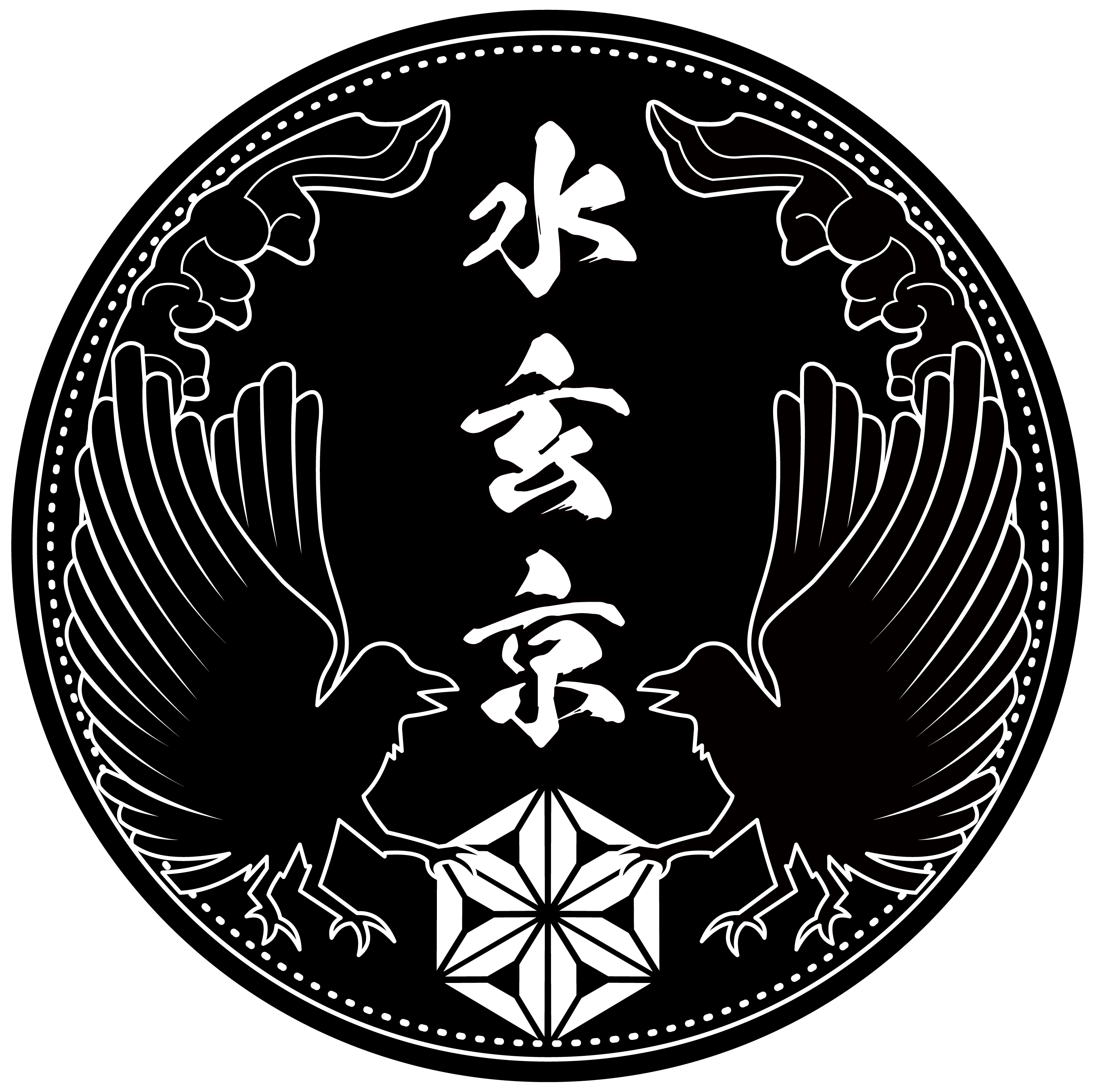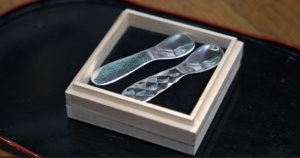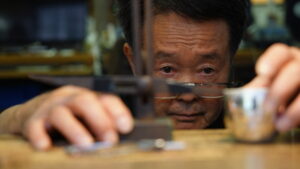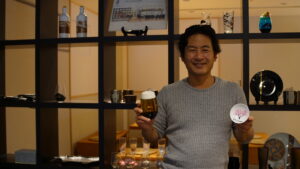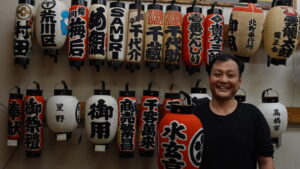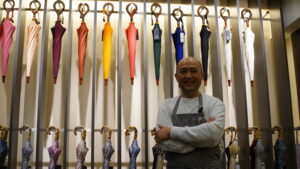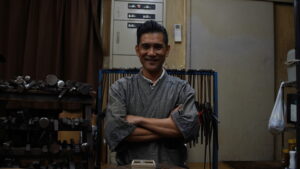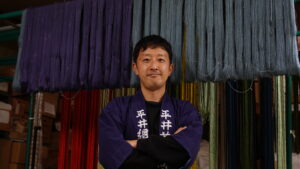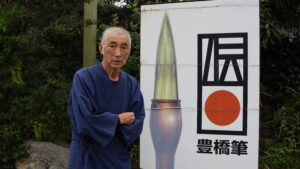Our interview this time was with Yoshimi Ishiyama, who naturally smiles when she talks about bamboo. Her latest hobby is practicing an instrument called shou, which is part of gagaku (ancient Japanese court music), and she recently performed it at a local festival. When she makes bamboo crafts, she tries to create high quality products that are one step above what people are looking for, which is made by her handiwork. We asked Ms. Ishiyama about her background and future plans.

- —What is the origin of “Chikusei,” which is your trade name?
-
This is the name of the futsal team I originally belonged to. When I was training at Nagaoka Meichiku Corporation, a bamboo shop in Kyoto, I created a futsal team consisting of Mr. Mashita, the representative of the company, and the bamboo shop. The name of the team was called “Bamboo Boosters”. Actually, I have never belonged to such a team because I am not good at working in a team or a group. But when I belonged to the team, I learned a lot, and it made me think that how to build a team, how to cooperate, how to use expenses, etc. I received this name because it is like a starting point for me, and I still like it very much.
- —What did make you interest in bamboo crafts?
-
I don’t have a clear trigger, but for some reason I have always had a lot of opportunities to interact with bamboo. For example, I practiced shinobue flute, which made of bamboo for local musical performances, and there was a bamboo fence at my parents’ house, and I started thinking that I would like to make something like that too. The auntie who taught me how to play the shinobue flute made her own shimenawa rope for New Year’s decorations, and when I imagined making something I had taken for granted, I thought it was amazing, and I wanted to try making one myself. I had always liked making things with my hands. Also, I like the idea of people being pleased when they see, touch, and use what I have made.

- —What was your career path?
-
I spent my high school years in Chiba Prefecture, worked part-time for about two years, and then went to a crafts college in Kyoto. I liked Chiba Prefecture, so I was planning to come back, and I had no intention of living in Kyoto for a long time. After graduating from the vocational school, I joined Nagaoka Meitchiku Co. The president of the company was the president of the vocational school, and when I went to ask him to join the company, he turned me down because there was no work, but I found out that they produced many bamboo fences among the bamboo shops in Kyoto. From this, I tried several times, and he allowed me to join. My first boss was also Mr. Mashita, who was a very reliable senior staff member. Mashita-san is an active person, so he always chose the best path for me that suited the situation. Looking back on it now, I am deeply grateful that my first boss was Mr. Mashita.

- —Do you have any memorable moments from the seven years you worked at Nagaoka Meichiku after graduating from the vocational school?
-
I guess I would have to say the fire that burned down our workshop. The fire happened on Christmas Eve, three years after I started working there. I learned many things during the four years I worked in Kyoto from there.
- —What kind of things did you learn at Nagaoka Meichiku?
-
I learned the most from what Mr. Mashita used to say, “Accept everything and move forward”. It is a quote from professional wrestler Hiroshi Tanahashi, and it has been imprinted on me because he used to say it at every moment (laugh). That’s how you must accept the situation of being burned down in a fire. I have been able to “accept” minor things that have happened in the past by myself, but I felt that I could not do anything on my own in the case of natural disasters.

- ―It was a very difficult period of training. Did you ever think of quitting the job at the time of the fire, or thinking of doing something else?
-
I was actually thinking of going back to Chiba, but the whole company was in trouble, so I couldn’t say I would quit. Also, I didn’t think about doing any other work. (laughs) I thought I had to work desperately for now. But it wasn’t just the negative things. Thanks to this period, I was able to talk a lot with Mashita-san, and I am very honored to be able to see the company’s management closer than anyone else.
- ―How did you start your own business?
-
After working in Kyoto for seven years, I went to Chiba to learn how to make Boshu Uchiwa. I wanted to work at a bamboo shop in Chiba Prefecture if there was one, but the only bamboo shops in Chiba were bamboo material stores that sold bamboo material for seaweed cultivation. Also, there were no workshops that made handicrafts. As I learned about the craft, I saw that there was a lack of successors, so I became a craftsman of Boshu Uchiwa, a type of Japanese fan that uses the same bamboo.
- ―Is the working style like a master-student relationship?
-
Well, there was no money involved, and I just went there and learned things. At the time, I was vaguely thinking of going independent, but there was a senior worker who lived in the same area at the time who worked as a steeplejack, and he let me help him with his work while I couldn’t eat. From the beginning, I didn’t feel like I was going to make a lot of money selling more and more Uchiwa. I knew it wasn’t something I could sell right away, and in the meantime, I was working at other jobs to improve my skills.

- ―What is the most enjoyable moment for you when you are making Uchiwa?
-
I enjoy when the product is completed and when a customer buys it. We demonstrate our products at events, and I enjoy communicating with people during these demonstrations, and I learn a lot when thinking about future products.
- ―What is the attractiveness of Uchiwa for you?
-
The quality of the wind is gentle, and it is very practical. As the name “me-dake” means “woman’s bamboo,” it has a tenacious and flexible texture. I think it is good for the body. It does not get too cold, so it is very appreciated by the elderly. If you were to fan it, I think it can get heavy and hot, but as our Uchiwa is lightweight, it is really comfortable to use it.
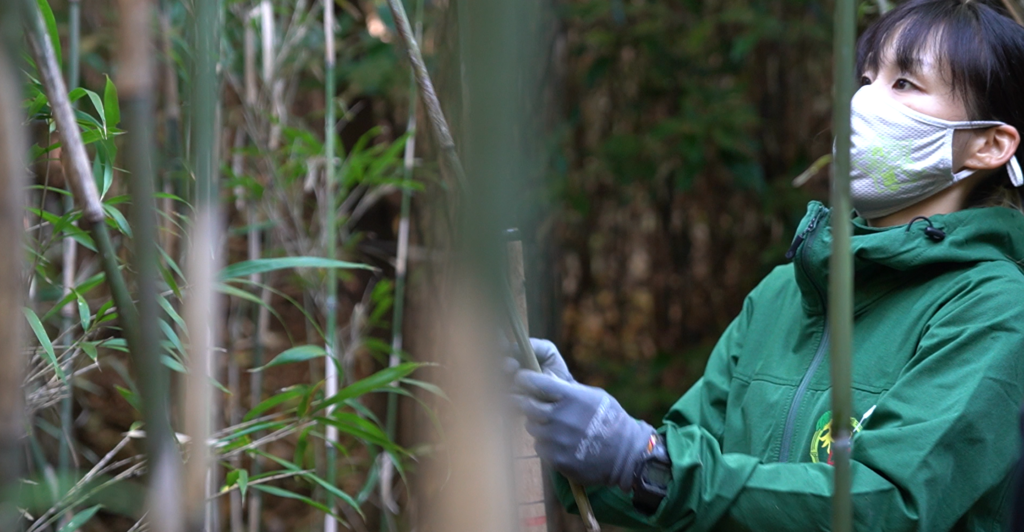
- ―What would you like to say to the young people who will enter the Japanese traditional craft industry in the future?
-
I can’t speak highly of it. I think they should do what they like without worrying about titles such as “craftsman” or “artist. I make traditional crafts, but traditional craftspeople also do wholesale work, so if you ask me if they are “crafts,” I think they are “folk art,”. Also, it is difficult to distinguish between these two. To the people around me, I am like an artist, and I don’t really have a definition of what I mean by that.
- ―Please tell us about your future plan for Takeboshi!
-
Personally, I would like to go overseas. Chiba Prefecture has Narita Airport, so I would like to do demonstration sales at such places. I would like to let people know more and more about Uchiwa regardless of nationality and gender. In Europe, I would like to visit Paris. The thought of having one of my works placed in the Louvre makes me very excited (laughs).

After the interview
We visited Mr. Ishiyama at his workshop at 8:00 a.m. and filming of the process from bamboo felling to the completion of Uchiwa, but he was smiling throughout the interview. His passion for bamboo crafts is as strong as anyone else’s, and he continues to think about bamboo and create something new even on his days off. He is a man who is determined to make it on one path, and his story is similar to that of Mr. Ishiyama’s first boss, Mr. Mashita. I felt again that “accept everything and move forward” is a good phrase. It was a day that made me feel once again that these are good words.
You can watch the making process on YouTube!
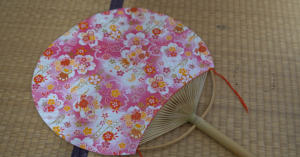
Suigenkyo Online Store
We offer a wide range of products including tableware, accessories, and interior design.
Suigenkyo YouTube
You can see the making process of the products listed on Suigenkyo Online Store.
